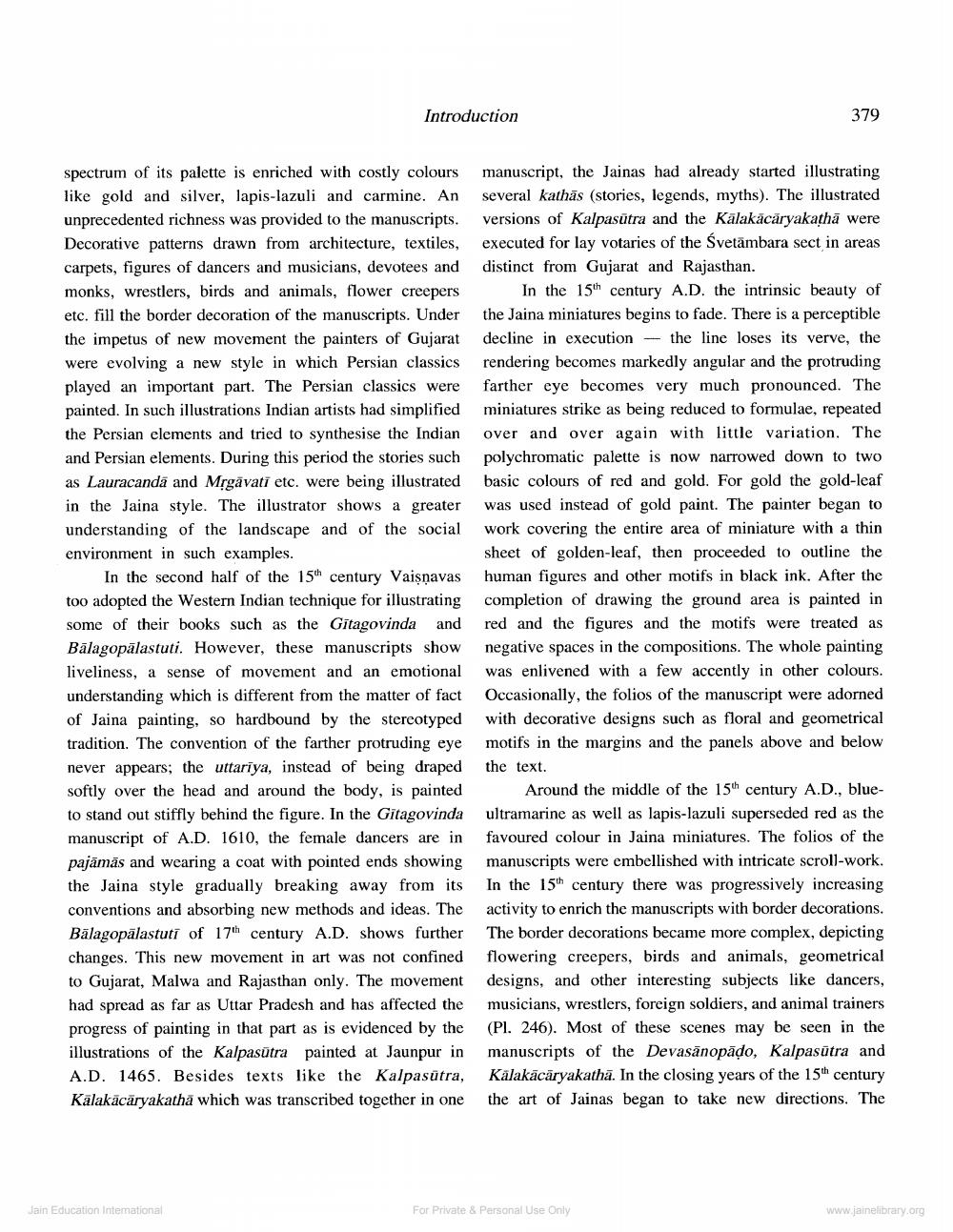________________
Introduction
379
spectrum of its palette is enriched with costly colours like gold and silver, lapis-lazuli and carmine. An unprecedented richness was provided to the manuscripts. Decorative patterns drawn from architecture, textiles, carpets, figures of dancers and musicians, devotees and monks, wrestlers, birds and animals, flower creepers etc. fill the border decoration of the manuscripts. Under the impetus of new movement the painters of Gujarat were evolving a new style in which Persian classics played an important part. The Persian classics were painted. In such illustrations Indian artists had simplified the Persian elements and tried to synthesise the Indian and Persian elements. During this period the stories such as Lauracanda and Mrgāvati etc. were being illustrated in the Jaina style. The illustrator shows a greater understanding of the landscape and of the social environment in such examples.
In the second half of the 15th century Vaisnavas too adopted the Western Indian technique for illustrating some of their books such as the Gitagovinda and Bālagopālastuti. However, these manuscripts show liveliness, a sense of movement and an emotional understanding which is different from the matter of fact of Jaina painting, so hardbound by the stereotyped tradition. The convention of the farther protruding eye never appears; the uttariya, instead of being draped softly over the head and around the body, is painted to stand out stiffly behind the figure. In the Gitagovinda manuscript of A.D. 1610, the female dancers are in pajāmās and wearing a coat with pointed ends showing the Jaina style gradually breaking away from its conventions and absorbing new methods and ideas. The Bālagopālastuti of 17th century A.D. shows further changes. This new movement in art was not confined to Gujarat, Malwa and Rajasthan only. The movement had spread as far as Uttar Pradesh and has affected the progress of painting in that part as is evidenced by the illustrations of the Kalpasūtra painted at Jaunpur in A.D. 1465. Besides texts like the Kalpasūtra, Kālakācāryakathā which was transcribed together in one
manuscript, the Jainas had already started illustrating several kathās (stories, legends, myths). The illustrated versions of Kalpasūtra and the Kälakācāryakathā were executed for lay votaries of the Svetämbara sect in areas distinct from Gujarat and Rajasthan.
In the 15th century A.D. the intrinsic beauty of the Jaina miniatures begins to fade. There is a perceptible decline in execution - the line loses its verve, the rendering becomes markedly angular and the protruding farther eye becomes very much pronounced. The miniatures strike as being reduced to formulae, repeated over and over again with little variation. The polychromatic palette is now narrowed down to two basic colours of red and gold. For gold the gold-leaf was used instead of gold paint. The painter began to work covering the entire area of miniature with a thin sheet of golden-leaf, then proceeded to outline the human figures and other motifs in black ink. After the completion of drawing the ground area is painted in red and the figures and the motifs were treated as negative spaces in the compositions. The whole painting was enlivened with a few accently in other colours. Occasionally, the folios of the manuscript were adorned with decorative designs such as floral and geometrical motifs in the margins and the panels above and below the text.
Around the middle of the 15th century A.D., blueultramarine as well as lapis-lazuli superseded red as the favoured colour in Jaina miniatures. The folios of the manuscripts were embellished with intricate scroll-work. In the 15th century there was progressively increasing activity to enrich the manuscripts with border decorations. The border decorations became more complex, depicting flowering creepers, birds and animals, geometrical designs, and other interesting subjects like dancers, musicians, wrestlers, foreign soldiers, and animal trainers (Pl. 246). Most of these scenes may be seen in the manuscripts of the Devasānopādo, Kalpasūtra and Kalakācāryakathā. In the closing years of the 15th century the art of Jainas began to take new directions. The
Jain Education Intemational
For Private & Personal Use Only
For Private & Personal Use Only
www.jainelibrary.org




